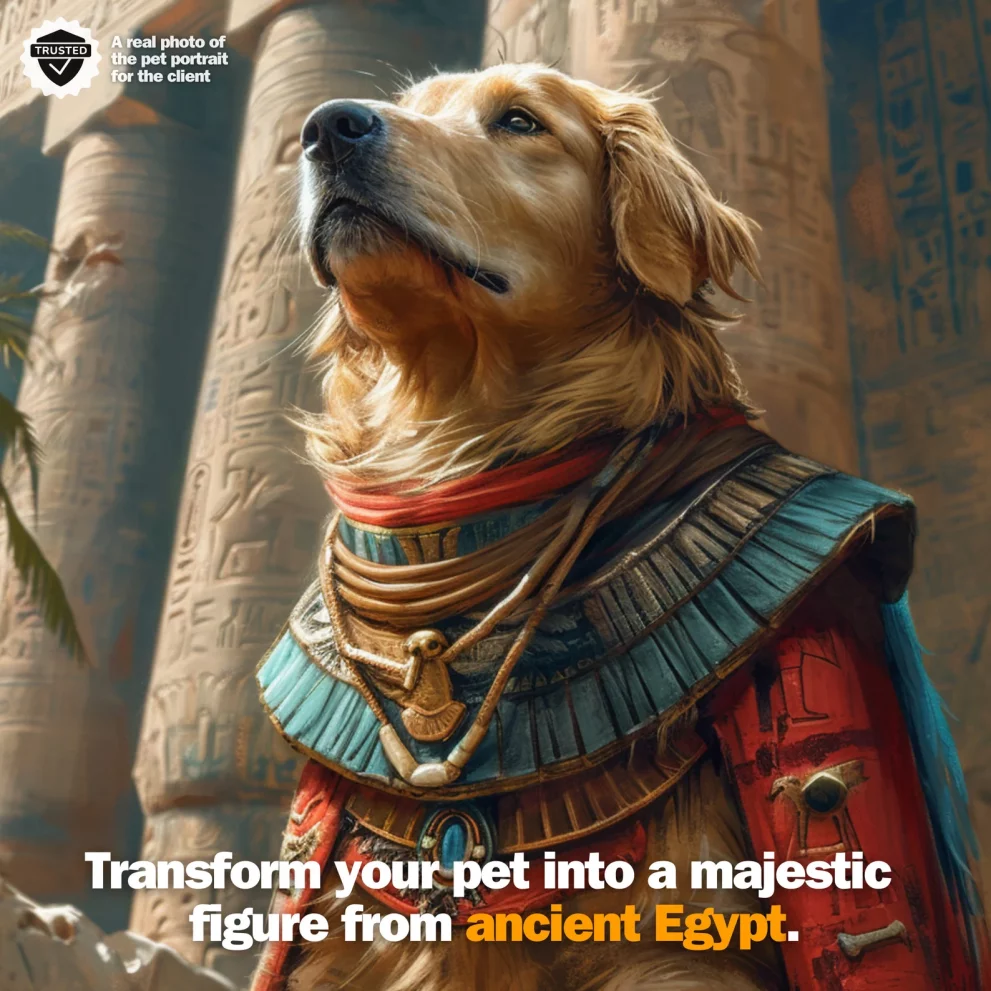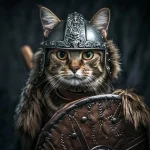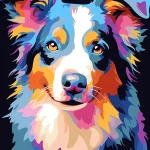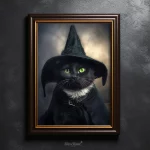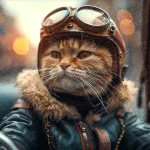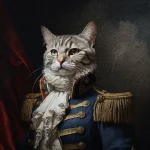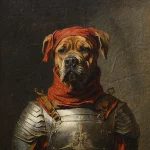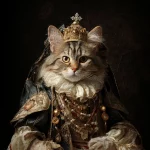The loss of a beloved pet can be a devastating experience, leaving a profound sense of emptiness and sorrow in the lives of those who cherished them. For many, pets are more than just animals—they are companions, confidants, and family members who offer unconditional love and loyalty.
When they pass away, the grief can be overwhelming, and the healing process can seem insurmountable. In such times of sorrow, finding ways to honor and remember the bond shared with a pet can be an essential part of coping with the loss.
One powerful and increasingly popular method of doing so is through pet portraits.
These portraits serve as more than just a visual reminder of a pet; they become a meaningful tool for emotional healing, helping grieving owners to process their loss, celebrate the life of their pet, and maintain a lasting connection to the cherished memories they hold dear.
This exploration delves into the emotional healing power of pet portraits, highlighting their role in the grieving process and their capacity to bring comfort and closure to those mourning the loss of a beloved animal companion.
The Deep Bond Between Pets and Their Owners
The bond between pets and their owners is a unique and profound relationship that transcends the typical dynamics of human connections. Unlike many human relationships, the bond with a pet is often characterized by a deep sense of unconditional love and loyalty, devoid of judgment or expectation.
Pets are nonjudgmental, offering comfort and companionship without the complications that can arise in human relationships. They are there during both the best and worst times of our lives, providing solace, joy, and a sense of security.
Pets often become integrated into the daily lives of their owners in a way that few other beings can. This integration is not just physical—such as a dog following its owner from room to room, or a cat curling up at the foot of the bed—it is also emotional and psychological.
The routines and rituals that develop around pet ownership, such as daily walks, feeding times, or shared quiet moments, create a sense of rhythm and continuity in our lives. These rituals help to structure our days and provide a comforting predictability that is often soothing.
Moreover, pets serve as a constant source of emotional support. In times of stress, sadness, or loneliness, the presence of a pet can be incredibly grounding. Many pet owners find that simply petting their animal can reduce anxiety and create a sense of calm.
This physical interaction releases oxytocin, a hormone associated with bonding and relaxation, which helps to alleviate feelings of distress. Pets also help to mitigate the effects of depression, providing a reason to get up in the morning, engage in physical activity, and interact with the world.
The emotional bond between pets and their owners is particularly strong because it is built on a foundation of mutual trust and affection. Pets rely on their owners for care, and in return, they offer companionship and loyalty.
This relationship is often described as symbiotic; while the owner provides for the physical needs of the pet, the pet fulfills an emotional need in the owner. This mutual dependence deepens the connection, making the relationship with a pet feel irreplaceable.
When a pet dies, this bond is abruptly severed, leading to a profound sense of loss. The grief that follows is often as intense as that experienced after the loss of a human loved one, and in some cases, even more so. This is because pets are such a constant presence in our lives, and their absence can leave a void that is difficult to fill. The loss of a pet can disrupt the daily routines and rituals that once brought comfort, making the owner feel disoriented and lost.
Furthermore, the loss of a pet can bring about feelings of loneliness and isolation. Pets are often the first to greet us when we come home and the last to say goodnight. Their absence can make the home feel empty and quiet, amplifying the sense of loneliness. This can be particularly difficult for those who live alone or who relied heavily on their pet for companionship.
In addition to the emotional impact, the loss of a pet can also trigger a sense of disenfranchised grief, where the depth of the owner’s sorrow is not fully recognized or validated by others.
Society often minimizes the grief associated with the loss of a pet, viewing it as less significant than the loss of a human loved one. This can make it difficult for grieving pet owners to find the support they need, leading to feelings of isolation and unresolved grief.
Despite these challenges, the deep bond shared with a pet can also be a source of strength during the grieving process. The memories of the love and companionship shared can provide comfort and solace, helping the owner to navigate the difficult emotions that arise after the loss.
This is where the power of pet portraits comes into play, offering a way to honor and remember this special bond in a tangible and meaningful way.
The Role of Memory in the Healing Process
Memory is a powerful tool in the healing process, particularly when dealing with the loss of a beloved pet. Memories allow us to hold onto the essence of our pets, keeping them alive in our hearts and minds even after they are gone.
For pet owners, memories of their pets are often intertwined with specific moments, routines, and interactions that were unique to their relationship. These memories can evoke a range of emotions, from joy and warmth to sorrow and longing, playing a crucial role in how we process grief.
The memories we have of our pets are often vivid and detailed, as they are linked to the sensory experiences of everyday life. The sound of a dog’s bark, the feel of a cat’s fur, or the sight of a pet waiting by the door can all trigger powerful recollections of the time spent together.
These sensory memories can be both comforting and painful, as they remind us of the presence that is now absent. However, these memories are also what allow us to keep the connection with our pet alive, even after their death.
In the initial stages of grief, these memories can be overwhelming. The pain of loss is fresh, and every reminder of the pet can trigger a wave of sadness and longing. This is a natural part of the grieving process, as the mind grapples with the reality of the loss.
During this time, it is common for pet owners to seek out ways to preserve these memories, whether through photographs, keepsakes, or rituals that honor the pet’s life.
Memory plays a crucial role in the process of memorialization. Memorials, in whatever form they take, are ways of externalizing memory—turning the intangible into something tangible. This is where pet portraits can be particularly powerful.
A portrait serves as a lasting tribute, a visual representation of the pet that captures not just their appearance, but also their spirit and personality.
Unlike photographs, which capture a single moment in time, a portrait can encapsulate the essence of the pet, offering a more holistic and emotional representation.
The process of creating or commissioning a pet portrait is itself an act of memory. It requires the owner to reflect on their pet’s life, to recall the details that made them unique, and to express what their pet meant to them.
This act of reflection can be deeply therapeutic, as it allows the owner to engage with their grief in a constructive way. Rather than avoiding the pain of loss, the owner is encouraged to confront it, to delve into their memories, and to find a way to honor them.
In the long term, memory continues to play a central role in the healing process.
Over time, the sharpness of grief may soften, but the memories of the pet remain. These memories can bring comfort and a sense of continuity, reminding the owner that the bond they shared with their pet is something that cannot be erased by death.
A pet portrait serves as a physical manifestation of these memories, a touchstone that the owner can return to whenever they wish to reconnect with their pet’s memory.
Furthermore, memory is not just about looking back; it is also about moving forward. The memories of a beloved pet can influence how an owner approaches future relationships with other pets or animals.
The lessons learned, the love shared, and the experiences had with one pet can inform how an owner bonds with another. In this way, memory helps to bridge the past with the present, allowing the love for a pet to continue influencing the owner’s life in positive ways.
In conclusion, memory is an integral part of the grieving and healing process. It allows pet owners to hold onto the love and connection they shared with their pet, even after their death.
Pet portraits, as a form of memorialization, offer a powerful way to preserve and honor these memories, providing comfort and solace in the face of loss. Through the act of remembering, pet owners can find a way to heal, to celebrate the life of their pet, and to carry their memory forward into the future.
The Therapeutic Benefits of Pet Portraits
Art has long been recognized as a powerful tool for emotional expression and healing.
Whether through creation or observation, art allows individuals to process complex emotions, explore their inner world, and find a sense of peace.
Pet portraits, as a form of art, offer a unique and deeply personal way for grieving pet owners to engage with their emotions and navigate the loss of their beloved companion.
A Tangible Connection to the Past
One of the most immediate and profound benefits of a pet portrait is the tangible connection it provides to the past. When a pet dies, the physical presence that was once a constant source of comfort and companionship is suddenly gone.
This absence can be deeply jarring, leaving the owner feeling disconnected and adrift. A pet portrait offers a way to bridge this gap, providing a visual and emotional link to the past.
The process of commissioning or creating a pet portrait involves reflecting on the pet’s life, their unique traits, and the special bond that was shared. This act of reflection is therapeutic in itself, as it requires the owner to focus on the positive memories and emotions associated with their pet.
By engaging with these memories, the owner can begin to reconnect with the aspects of their pet’s life that brought them joy and comfort.
A pet portrait serves as a permanent reminder of the pet’s presence in the owner’s life. Unlike photographs, which capture a specific moment in time, a portrait can encapsulate the overall essence of the pet, reflecting their personality, spirit, and the relationship they shared with their owner.
This makes the portrait not just a visual representation, but also an emotional one—a way for the owner to hold onto the feelings of love and connection that their pet brought into their life.
This tangible connection to the past can be incredibly comforting, particularly in the early stages of grief. When the pain of loss is still fresh, having a focal point for these emotions can help the owner process their grief in a more structured and manageable way.
The portrait becomes a touchstone, a way to channel the intense emotions of loss into something positive and meaningful.
A Focus for Grief
Grief is a complex and multifaceted emotion that can be difficult to navigate. It often involves a chaotic mix of sadness, anger, confusion, and longing, which
can feel overwhelming and disorienting. One of the challenges of grieving is finding a way to channel these emotions in a way that allows for healing and closure. A pet portrait can serve as a focus for these emotions, providing a concrete object around which the grieving process can revolve.
Having a focal point for grief can be incredibly helpful in organizing and processing emotions. The portrait offers a way to externalize the grief, turning it into something that can be seen, touched, and interacted with.
This can help the owner to feel less overwhelmed by their emotions, as they are able to focus their grief on the portrait and the memories it represents.
The act of engaging with the portrait—whether through looking at it, talking to it, or simply sitting in its presence—can provide a sense of ritual and routine that is often comforting during times of loss.
This ritualization of grief allows the owner to create a space for mourning within their daily life, helping them to process their emotions in a structured and intentional way.
Moreover, the portrait can serve as a reminder that the grief is not something that needs to be avoided or suppressed, but rather something that can be acknowledged and honored. By focusing on the portrait, the owner is given permission to feel their grief fully, without fear of judgment or dismissal.
This can be particularly important in cases where the grief is disenfranchised, as it allows the owner to validate their own emotions and experience.
A Celebration of Life
While the death of a pet is a sorrowful event, a pet portrait offers a way to shift the focus from the loss to the life that was lived.
This shift in perspective can be a powerful tool in the healing process, as it encourages the owner to remember their pet not just for the sadness of their passing, but for the joy and love they brought into their life.
A well-crafted pet portrait can capture the unique quirks, personality traits, and physical characteristics that made the pet special.
Whether it’s the mischievous glint in a dog’s eye, the regal posture of a cat, or the gentle demeanor of a horse, the portrait can highlight the qualities that made the pet a beloved companion.
This celebration of life can help to reframe the loss, turning it from a purely sorrowful event into an opportunity to honor and remember the pet’s life.
This focus on celebration rather than mourning can also help to shift the owner’s emotional state.
Instead of dwelling on the sadness of the loss, the portrait encourages the owner to remember the positive experiences and the love that was shared.
This can help to lift the owner out of the depths of grief, allowing them to find moments of joy and gratitude amidst the sadness.
In addition, a pet portrait can serve as a way to share the pet’s life with others. It can become a focal point for stories, memories, and conversations, allowing the owner to keep the pet’s memory alive within their social circle.
This communal aspect of remembrance can be deeply healing, as it reinforces the idea that the pet’s life had meaning and significance beyond their physical presence.
A Tool for Emotional Expression
For many people, expressing the depth of their grief can be challenging.
Words often fall short when it comes to conveying the complex emotions associated with loss. Art, however, offers a different mode of expression, one that can capture the nuances of emotion in ways that words cannot.
A pet portrait can serve as a powerful tool for emotional expression, allowing the owner to process and communicate their feelings in a visual and symbolic way.
The colors, textures, and composition of a portrait can reflect the owner’s emotional state, turning the portrait into a deeply personal and cathartic creation.
For example, a portrait that uses soft, muted colors might convey a sense of peace and acceptance, while one with bold, vibrant colors might express the intensity of the love and energy the pet brought into the owner’s life.
The choice of medium—whether oil, watercolor, or charcoal—can also influence the emotional tone of the portrait, adding another layer of meaning and expression.
For those who choose to create the portrait themselves, the act of drawing or painting can be a form of emotional release.
The physical act of creating allows the owner to engage with their grief in a hands-on way, channeling their emotions into the creative process.
This can be particularly therapeutic for those who struggle to articulate their feelings verbally, as it offers an alternative means of expression that is both personal and meaningful.
Even for those who commission a portrait from an artist, the process of selecting the elements of the portrait—such as the pose, background, and color palette—can be an act of emotional expression.
The choices made during the commissioning process reflect the owner’s feelings about their pet and their relationship, turning the portrait into a collaborative work that is infused with personal meaning.
A Source of Comfort
In times of grief, comfort can come from unexpected sources. For many grieving pet owners, simply having a visual representation of their pet can provide a sense of solace and peace.
A pet portrait can serve as a comforting reminder that, while their pet may be gone, the love and memories shared will always remain.
The presence of the portrait in the home can offer a sense of continuity, providing a link between the past and the present. It serves as a reminder that the pet’s spirit and essence are still part of the owner’s life, even if they are no longer physically present.
This ongoing connection to the pet can help to alleviate feelings of loneliness and sadness, offering a sense of companionship and comfort.
Moreover, the portrait can become a place of emotional refuge—a personal sanctuary where the owner can go to feel close to their pet.
Whether placed in a prominent spot in the home or in a more private location, the portrait can serve as a touchstone for moments of reflection, allowing the owner to reconnect with the love and bond they shared with their pet.
The comfort provided by the portrait is not just emotional, but also psychological. It offers a way to externalize the grief, turning it into something tangible and visible.
This can help to reduce the sense of isolation that often accompanies grief, as the portrait becomes a way to share the experience of loss with others.
Friends and family who see the portrait can offer their support and understanding, creating a sense of community and connection that is vital during the grieving process.
The Process of Creating a Pet Portrait
The process of creating a pet portrait is as significant as the final product itself.
Whether the portrait is commissioned from a professional artist or created by the pet owner, the journey of bringing the portrait to life can be a deeply meaningful and therapeutic experience.
This process involves reflection, emotional engagement, and a focus on honoring the life and memory of the beloved pet.
Commissioning a Pet Portrait
Commissioning a pet portrait involves collaborating with an artist to create a personalized representation of the pet.
This process typically begins with a consultation, during which the pet owner shares photographs, stories, and details about their pet’s personality, appearance, and significance in their life.
This initial step is more than just providing reference material for the artist; it is an opportunity for the pet owner to reflect on their pet’s life and articulate what made them special.
The consultation process allows the pet owner to revisit memories and emotions associated with their pet. This act of reflection can be deeply therapeutic, as it encourages the owner to focus on the positive aspects of their pet’s life—their unique quirks, the joy they brought, and the bond they shared.
By discussing these details with the artist, the owner is actively engaging in the process of memorialization, which can help to alleviate feelings of grief and loss.
Once the consultation is complete, the artist begins the process of creating the portrait. This stage involves translating the owner’s memories and descriptions into a visual form, capturing not only the physical likeness of the pet but also their personality and spirit.
The artist’s skill and sensitivity play a crucial role in this process, as they must balance technical accuracy with emotional expression. The goal is to create a portrait that resonates with the pet owner on a deep emotional level, evoking the essence of their beloved pet.
The collaboration between the artist and the pet owner can be a profoundly healing experience. It involves a shared focus on celebrating the pet’s life and honoring their memory, which can provide a sense of closure and peace.
The act of commissioning the portrait is a way for the owner to take an active role in their grieving process, transforming their loss into something positive and meaningful.
When the portrait is finally completed and delivered to the owner, it often evokes a powerful emotional response. The sight of their beloved pet captured in art can bring a sense of comfort, joy, and connection, helping the owner to reconcile with their grief.
The portrait becomes a lasting tribute, a visual reminder of the pet’s life and the love that was shared.
Creating a Pet Portrait
For those who have artistic inclinations, creating a pet portrait themselves can be an incredibly powerful form of self-expression and healing. The process of drawing or painting their pet allows the owner to engage with their grief in a hands-on way, channeling their emotions into the creative process.
This can be a way to work through feelings of sadness and loss, transforming them into something beautiful and lasting.
Even for those who are not professional artists, the act of creating a pet portrait can be deeply meaningful. The portrait does not have to be perfect; what matters is the intention and emotion behind it.
The process of creating the portrait allows the owner to spend time with their pet’s memory, reflecting on the moments they shared and the bond they had. This act of creation can be a way to reconnect with the pet, offering a sense of closeness and connection that can be comforting during the grieving process.
Creating a pet portrait also provides an opportunity for emotional expression. Through the choice of colors, composition, and medium, the owner can convey their feelings about their pet and their loss. This can be a cathartic experience, as it allows the owner to
externalize their grief and turn it into something tangible and meaningful. The act of creating can be a form of emotional release, helping the owner to process their feelings and find a sense of peace.
The finished portrait, whether created by the owner or commissioned from an artist, serves as a lasting tribute to the pet.
It is a visual representation of the love, joy, and companionship that the pet brought into the owner’s life. For the grieving pet owner, this portrait becomes a source of comfort and solace, a way to keep the memory of their beloved pet alive.
Conclusion
The emotional healing power of pet portraits for grieving owners is deeply significant, offering a unique way to navigate the profound loss of a beloved animal companion.
These portraits serve not just as artistic representations, but as heartfelt tributes that encapsulate the enduring bond between pets and their owners.
By capturing the essence of a pet’s personality and spirit, a portrait becomes a lasting keepsake that helps owners preserve cherished memories, providing a tangible connection to the past.
Through the creation or commissioning of a pet portrait, grieving owners find a focal point for their grief, transforming their sorrow into a meaningful and positive expression of love.
The process of reflecting on the life of a pet and the bond shared can be both therapeutic and comforting, offering a structured way to process complex emotions.
Moreover, these portraits shift the focus from loss to celebration, allowing owners to remember and honor the joy and companionship their pet brought into their lives.
In the end, a pet portrait is more than just an image—it’s a powerful tool for emotional healing, providing solace, comfort, and a sense of closure.
It stands as a testament to the enduring connection between a pet and their owner, a connection that continues to offer support and comfort long after the pet is gone.
For grieving pet owners, a portrait is not just a way to remember their pet; it’s a way to carry their memory forward, ensuring that the love and bond they shared remains a cherished part of their lives forever.
